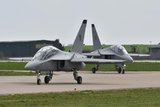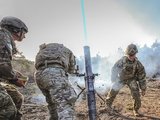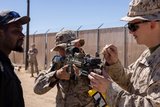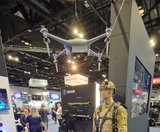Leonardo supports Italian Air Force for Spartan Alliance
Leonardo recently supported the Italian Air Force’s participation in the ‘Spartan Alliance’ virtual air exercise, the company announced on 20 July.
The exercise was held from 18-20 July, immediately following the public launch of the public-private partnership between Leonardo and the Italian Air Force to create an International Flight Training School (IFTS). Other countries participating in the exercise included the US, UK, Germany and France.
The collaboration saw Leonardo provide its Realistic Intelligent Agent Computer Environment (RIACE) system, a distributed training solution that generates complex, realistic scenarios that replicate operational missions.
RIACE brought together a number of different sites and assets into a merged synthetic environment, including Tornado, Eurofighter, T-346 and Predator aircraft, the Integration Test Bed at the Pratica di Mare air base, C2 systems, missile-defence systems and Joint Terminal Attack Controller units.
RIACE has been developed to make the best use of Italian Air Force’s existing simulation capabilities, maximising and extending their functionality and training performance. During Spartan Alliance, the system demonstrated the ability to offer collective training in a synthetic environment, allowing pilots flying in aircraft simulators at geographically-separate bases to train inside a common virtual scenario. Interaction within the simulated environment was ‘man-in-the-loop’.
RIACE allows pilots to train for challenging and complex scenarios, to interact with the command and control chain and to practice with allied forces in joint and coalition missions.
The solution can also be used to test new systems and experiment with new tactics. With the use of RIACE, all users involved (air crew, command and control, operations command, ISR systems, air traffic control and ground support) can take part in mission preparation and training, interacting with each other while remaining at their home sites.
The IFTS is designed for pilots who will eventually fly front-line fighter jets. In future, the school’s activities could expand to include training pilots of other fixed-wing aircraft, rotorcraft and remotely-piloted air systems. The IFTS will benefit from the technical excellence of an integrated training system based on the M-346 aircraft and Live, Virtual and Constructive simulation technology.
More from Training
-
![Cubic tailors mortar simulator for the US Army]()
Cubic tailors mortar simulator for the US Army
The company’s mortar trainer received improvements based on soldier’s feedback.
-
![Saab expands footprint in the US]()
Saab expands footprint in the US
The company will operate in two new locations in the coming years to better support US services.
-
![How terrain management capabilities can improve military training]()
How terrain management capabilities can improve military training
This type of tool provides more realistic training easing the incorporation of new scenarios that accurately represent the threats of the battlefield.
-
![I/ITSEC 2024: Australian Army approaches second phase of countermining training]()
I/ITSEC 2024: Australian Army approaches second phase of countermining training
The Engineering Corps has been conducting individual instruction using FLAIM Systems’ Sweeper and should start collective deployments in 2025.
-
![I/ITSEC 2024: Zeiss introduces Velvet 4K SIM projector for night flight simulation]()
I/ITSEC 2024: Zeiss introduces Velvet 4K SIM projector for night flight simulation
The next-generation platform is motion-compatible and can be used in OTW and NVG applications.
-
![I/ITSEC 2024: Saab introduces UAV live training capability]()
I/ITSEC 2024: Saab introduces UAV live training capability
The system can be used to prepare soldiers for both drone offensive operations and CUAS missions.
























